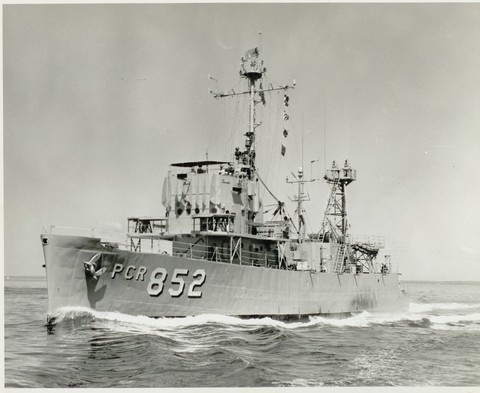 |
| BRP Miguel Malvar (PS-19) is the lead ship of the Miguel Malvar class of corvettes of the Philippine Navy. She was originally built as USS PCE(R)-852, a PCE(R)-848-class rescue patrol craft escort for the United States Navy during World War II. She was acquired by the Philippine Navy in April 1976 and later on commissioned as Miguel Malvar after Miguel Malvar y Carpio. The ship is in active service. Along with other World War II-era ships of the Philippine Navy, Miguel Malvar is one of the oldest active fighting ships in the world today. |
Commissioned in the US Navy as the USS PCER-852 in 1944, she was first assigned in the Atlantic theatre of operations engaged in patrolling and training. On 1 August 1944, PCER-852 stood out of Bermuda bound for Norfolk, Virginia with 26 prisoners of war—sailors from the German submarine U-505, captured in June by a “hunter-killer” group formed around escort carrier USS Guadalcanal (CVE-60).
Relocating to the Pacific theatre of operations, her duties included treatment of wounded sailors and soldiers, and ASW patrols during the invasion of the Philippines at Leyte Gulf and Lingayen Gulf, and in the operations at Okinawa. During her six months in the war zone, her medical staff and crew handled over 1300 dead, critically wounded, and ships' survivors. After the war, she was placed under the Atlantic Reserve Fleet but was not decommissioned.
Early in 1946, however, she was converted into an experimental ship to test infrared equipment for the Bureau of Ships. She had her armament removed and her hospital facilities converted to workspaces for test equipment. At that time, she was redesignated E-PCER-852. She completed the conversion in May 1946. In September 1947, the Bureau of Ships shifted the infrared test program to the Underwater Sound Laboratory at New London, Connecticut, and E-PCER-852 operated from that base.
For the next 18 years, the ship continued to do experimental work. By the early 1950s, the nature of her test work expanded from infrared gear to include optical communications equipment, sonar apparatus, weather gear, and various other items of hardware. In addition to the Bureau of Ships, she did test work for both the Bureau of Ordnance and the Office of Naval Research. On 15 February 1956, the ship was named USS Brattleboro. She continued her experimental duties for nearly a decade after receiving her name. During that time, her zone of operations also expanded to include the coastal waters along the southeastern United States and thence into the West Indies. On 1 October 1965, Brattleboro was ordered to Philadelphia to begin inactivation. Decommissioned at Philadelphia and struck from the Navy list on 1 November 1965.
She was then transferred to the Republic of Vietnam on 11 July 1966. She served the Republic of Vietnam Navy as Ngọc Hồi (HQ-12) up until her escape to the Philippines in 1975, together with other South Vietnamese Navy ships and their respective crew.
After she was cleaned, repaired and made ready for service, she was formally acquired by the Philippine Navy on 5 April 1976 and was commissioned together with other ex-RVN ships on 7 February 1977. She underwent extensive overhaul and refitting of armaments and was commissioned into the Philippine Navy as RPS Miguel Malvar (PS-19).
 |
| BRP Miguel Malvar (PS 19) steams alongside the national security cutter USCGC Waesche (WMSL 751) during a replenishment at sea approach (RASAP) training event at CARAT 2012 - Philippines. |
She initially served the Philippine Navy as RPS Miguel Malvar (PS-19) until she was renamed to BRP Miguel Malvar effective 23 June 1980. Between 1990 and 1992 the Miguel Malvar underwent major overhaul, weapons and radar systems refit, and upgrade of communications gear.
She is currently assigned with the Patrol Force of the Philippine Fleet and is considered as one of the most decorated ship of the Navy.


No comments:
Post a Comment